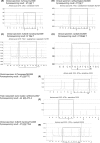Detection of molecular markers of drug resistance in 2009 pandemic influenza A (H1N1) viruses by pyrosequencing
- PMID: 20028826
- PMCID: PMC2826019
- DOI: 10.1128/AAC.01417-09
Detection of molecular markers of drug resistance in 2009 pandemic influenza A (H1N1) viruses by pyrosequencing
Abstract
The M2 blockers amantadine and rimantadine and the neuraminidase (NA) inhibitors (NAIs) oseltamivir and zanamivir are approved by the FDA for use for the control of influenza A virus infections. The 2009 pandemic influenza A (H1N1) viruses (H1N1pdm) are reassortants that acquired M and NA gene segments from a Eurasian adamantane-resistant swine influenza virus. NAI resistance in the H1N1pdm viruses has been rare, and its occurrence is mainly limited to oseltamivir-exposed patients. The pyrosequencing assay has been proven to be a useful tool in surveillance for drug resistance in seasonal influenza A viruses. We provide a protocol which allows the detection of adamantane resistance markers as well as the I43T change, which is unique to the H1N1pdm M2 protein. The protocol also allows the detection of changes at residues V116, I117, E119, Q136, K150, D151, D199, I223, H275, and N295 in the NA, known to alter NAI drug susceptibility. We report on the detection of the first cases of the oseltamivir resistance-conferring mutation H275Y and the I223V change in viruses from the United States using the approach described in this study. Moreover, the assay permits the quick identification of the major NA group (V106/N248, I106/D248, or I106/N248) to which a pandemic virus belongs. Pyrosequencing is well suited for the detection of drug resistance markers and signature mutations in the M and NA gene segments of the pandemic H1N1 influenza viruses.
Figures



References
-
- Abed, Y., M. Baz, and G. Boivin. 2006. Impact of neuraminidase mutations conferring influenza resistance to neuraminidase inhibitors in the N1 and N2 genetic backgrounds. Antivir. Ther. 11:971-976. - PubMed
-
- Baz, M., Y. Abed, J. McDonald, and G. Boivin. 2006. Characterization of multidrug-resistant influenza A/H3N2 viruses shed during 1 year by an immunocompromised child. Clin. Infect. Dis. 43:1555-1561. - PubMed
-
- Bright, R. A., M. J. Medina, X. Xu, G. Perez-Oronoz, T. R. Wallis, X. M. Davis, L. Povinelli, N. J. Cox, and A. I. Klimov. 2005. Incidence of adamantane resistance among influenza A (H3N2) viruses isolated worldwide from 1994 to 2005: a cause for concern. Lancet 366:1175-1181. - PubMed
-
- Centers for Disease Control and Prevention. 2009. Oseltamivir-resistant novel influenza A (H1N1) virus infection in immunosuppressed patients receiving oseltamivir therapy. MMWR Morb. Mortal. Wkly. Rep. 58:893-896. - PubMed
Publication types
MeSH terms
Substances
LinkOut - more resources
Full Text Sources
Other Literature Sources

